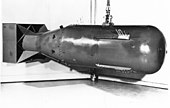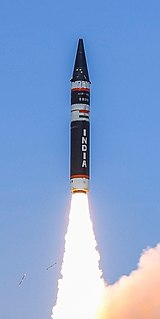
An intercontinental ballistic missile (ICBM) is a missile with a minimum range of 5,500 kilometres (3,400 mi) primarily designed for nuclear weapons delivery. Similarly, conventional, chemical, and biological weapons can also be delivered with varying effectiveness, but have never been deployed on ICBMs. Most modern designs support multiple independently targetable reentry vehicles (MIRVs), allowing a single missile to carry several warheads, each of which can strike a different target. India, Russia, the United States, North Korea, China, the United Kingdom and France are the only countries that have ICBMs.
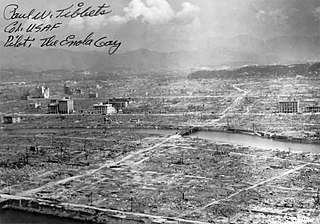
Mutual assured destruction (MAD) is a doctrine of military strategy and national security policy in which a full-scale use of nuclear weapons by two or more opposing sides would cause the complete annihilation of both the attacker and the defender. It is based on the theory of deterrence, which holds that the threat of using strong weapons against the enemy prevents the enemy's use of those same weapons. The strategy is a form of Nash equilibrium in which, once armed, neither side has any incentive to initiate a conflict or to disarm.

The LGM-30 Minuteman is an American land-based intercontinental ballistic missile (ICBM) in service with the Air Force Global Strike Command. As of 2021, the LGM-30G Minuteman III version is the only land-based ICBM in service in the United States and represents the land leg of the U.S. nuclear triad, along with the Trident submarine-launched ballistic missile (SLBM) and nuclear weapons carried by long-range strategic bombers.
Nuclear utilization target selection (NUTS) is a hypothesis regarding the use of nuclear weapons often contrasted with mutually assured destruction (MAD). NUTS theory at its most basic level asserts that it is possible for a limited nuclear exchange to occur and that nuclear weapons are simply one more rung on the ladder of escalation pioneered by Herman Kahn. This leads to a number of other conclusions regarding the potential uses of and responses to nuclear weapons.

The Strategic Arms Limitation Talks (SALT) were two rounds of bilateral conferences and corresponding international treaties involving the United States and the Soviet Union. The Cold War superpowers dealt with arms control in two rounds of talks and agreements: SALT I and SALT II.
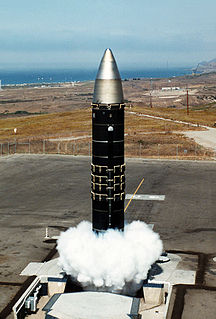
The LGM-118 Peacekeeper, originally known as the MX for "Missile, Experimental", was a MIRV-capable intercontinental ballistic missile (ICBM) produced and deployed by the United States from 1985 to 2005. The missile could carry up to 12 Mk.21 reentry vehicles, although treaty-limited to 10, each armed with a 300-kiloton W87 warhead. Initially, 100 MX ICBMs were planned to be built and deployed, but budgetary concerns eliminated the final procurement and only 50 entered service. Disarmament treaties signed after the Peacekeeper's development concluded in its eventual withdrawal from service in 2005.

The Strategic Rocket Forces of the Russian Federation or the Strategic Missile Forces of the Russian Federation are a separate-troops branch of the Russian Armed Forces that control Russia's land-based intercontinental ballistic missiles (ICBMs).
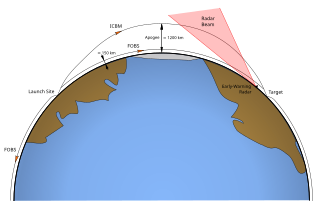
A Fractional Orbital Bombardment System (FOBS) is a warhead delivery system that uses a low earth orbit towards its target destination. Just before reaching the target, it deorbits through a retrograde engine burn.

The R-36 is a family of intercontinental ballistic missiles (ICBMs) and space launch vehicles (Tsyklon) designed by the Soviet Union during the Cold War. The original R-36 was deployed under the GRAU index 8K67 and was given the NATO reporting name SS-9 Scarp. It was able to carry three warheads and was the first Soviet MRV missile. The later version, the R-36M was produced under the GRAU designations 15A14 and 15A18 and was given the NATO reporting name SS-18 Satan. This missile was viewed by certain United States analysts as giving the Soviet Union first strike advantage over the U.S., particularly because of its rapid silo-reload ability, very heavy throw weight and extremely large number of re-entry vehicles. Some versions of the R-36M were deployed with 10 warheads and up to 40 penetration aids and the missile's high throw-weight made it theoretically capable of carrying more warheads or penetration aids. Contemporary U.S. missiles, such as the Minuteman III, carried up to three warheads at most.

The RT-2PM Topol is a mobile intercontinental ballistic missile designed in the Soviet Union and in service with Russia's Strategic Missile Troops. By the early 2020s, all SS-25 ICBMs will be replaced by versions of Topol-M.

Missile defense is a system, weapon, or technology involved in the detection, tracking, interception, and destruction of attacking missiles. Conceived as a defense against nuclear-armed intercontinental ballistic missiles (ICBMs), its application has broadened to include shorter-ranged non-nuclear tactical and theater missiles.

Flexible response was a defense strategy implemented by John F. Kennedy in 1961 to address the Kennedy administration's skepticism of Dwight Eisenhower's New Look and its policy of massive retaliation. Flexible response calls for mutual deterrence at strategic, tactical, and conventional levels, giving the United States the capability to respond to aggression across the spectrum of war, not limited only to nuclear arms.
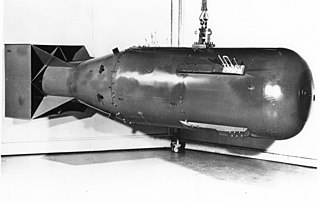
Nuclear weapons delivery is the technology and systems used to place a nuclear weapon at the position of detonation, on or near its target. Several methods have been developed to carry out this task.

Launch on warning (LOW) or fire on warning is a strategy of nuclear weapon retaliation that gained recognition during the Cold War between the Soviet Union and the United States. With the invention of intercontinental ballistic missiles (ICBMs), launch on warning became an integral part of mutually assured destruction (MAD) theory. Under the strategy, a retaliatory strike is launched upon warning of enemy nuclear attack while its missiles are still in the air and before detonation occurs. US land-based missiles can reportedly be launched within five minutes of a presidential decision to do so and submarine-based missiles within 15 minutes.

The MGM-134A Midgetman, also known as the Small Intercontinental Ballistic Missile (SICBM), was an intercontinental ballistic missile developed by the United States Air Force. The system was mobile and could be set up rapidly, allowing it to move to a new firing location after learning of an enemy missile launch. To attack the weapon, the enemy would have to blanket the area around its last known location with multiple warheads, using up a large percentage of their force for limited gains and no guarantee that all of the missiles would be destroyed. In such a scenario, the U.S. would retain enough of their forces for a successful counterstrike, thereby maintaining a deterrence.

A nuclear triad is a three-pronged military force structure that consists of land-launched nuclear missiles, nuclear-missile-armed submarines, and strategic aircraft with nuclear bombs and missiles. Specifically, these components are land-based intercontinental ballistic missiles (ICBMs), submarine-launched ballistic missiles (SLBMs), and strategic bombers. The purpose of having this three-branched nuclear capability is to significantly reduce the possibility that an enemy could destroy all of a nation's nuclear forces in a first-strike attack. This, in turn, ensures a credible threat of a second strike, and thus increases a nation's nuclear deterrence.
Dead Hand, also known as Perimeter, is a Cold War-era automatic nuclear weapons-control system that was used by the Soviet Union. The system remains in use in the post-Soviet Russian Federation. An example of fail-deadly and mutual assured destruction deterrence, it can automatically initiate the launch of the Russian intercontinental ballistic missiles (ICBMs) by sending a pre-entered highest-authority order from the General Staff of the Armed Forces, Strategic Missile Force Management to command posts and individual silos if a nuclear strike is detected by seismic, light, radioactivity, and pressure sensors even with the commanding elements fully destroyed. By most accounts, it is normally switched off and is supposed to be activated during times of crisis; however, it is said to remain fully functional and able to serve its purpose whenever it may be needed.
In nuclear strategy, a counterforce target is one that has a military value, such as a launch silo for intercontinental ballistic missiles, an airbase at which nuclear-armed bombers are stationed, a homeport for ballistic missile submarines, or a command and control installation.

Sentry, known for most of its lifetime as LoADS for Low Altitude Defense System, was a short-range anti-ballistic missile (ABM) design made by the US Army during the 1970s. It was proposed as a defensive weapon that would be used in concert with the MX missile, a US Air Force ICBM that was under development.
